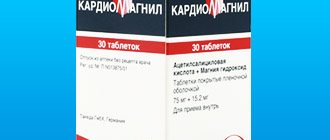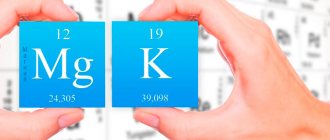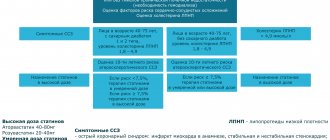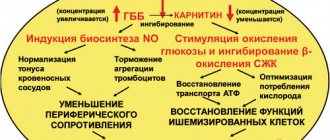Cardiomagnyl®
The drug should be used after a doctor's prescription.
ASA can provoke bronchospasm, as well as cause attacks of bronchial asthma and other hypersensitivity reactions. Risk factors include a history of bronchial asthma, hay fever, nasal polyposis, chronic respiratory diseases, and allergic reactions to other drugs (for example, skin reactions, itching, urticaria).
ASA can cause bleeding of varying severity during and after surgery. Several days before planned surgery, the risk of bleeding should be assessed in comparison with the risk of ischemic complications in patients taking low doses of ASA. If the risk of bleeding is significant, ASA should be temporarily discontinued.
The combination of ASA with anticoagulants, thrombolytics and antiplatelet drugs is accompanied by an increased risk of bleeding.
ASA in low doses can trigger the development of gout in predisposed patients (those with reduced excretion of uric acid).
The combination of ASA with methotrexate is accompanied by an increased incidence of side effects from the hematopoietic organs.
High doses of ASA have a hypoglycemic effect, which must be kept in mind when prescribing it to patients with diabetes mellitus receiving oral hypoglycemic agents and insulin.
When using systemic glucocorticosteroids (GCS) and salicylates in combination, it should be remembered that during treatment the concentration of salicylates in the blood is reduced, and after discontinuation of systemic glucocorticosteroids (GCS), an overdose of salicylates is possible.
The combination of ASA with ibuprofen is not recommended in patients with an increased risk of cardiovascular diseases: when used simultaneously with ibuprofen, there is a decrease in the antiplatelet effect of ASA in doses up to 300 mg, which leads to a decrease in the cardioprotective effects of ASA.
Exceeding the dose of ASA above the recommended therapeutic doses is associated with the risk of gastrointestinal bleeding. With long-term use of low doses of ASA as aggregative therapy, caution must be exercised in elderly patients due to the risk of gastrointestinal bleeding. When taking ASA simultaneously with alcohol, there is an increased risk of damage to the mucous membrane of the gastrointestinal tract and prolongation of bleeding time.
Instructions Cardiomagnyl
The drug should be used after a doctor's prescription.
ASA can provoke bronchospasm, as well as cause attacks of bronchial asthma and other hypersensitivity reactions. Risk factors include a history of bronchial asthma, hay fever, nasal polyposis, chronic respiratory diseases, and allergic reactions to other drugs (for example, skin reactions, itching, urticaria).
ASA can cause bleeding of varying severity during and after surgery. Several days before planned surgery, the risk of bleeding should be assessed in comparison with the risk of ischemic complications in patients taking low doses of ASA. If the risk of bleeding is significant, ASA should be temporarily discontinued.
The combination of ASA with anticoagulants, thrombolytics and antiplatelet drugs is accompanied by an increased risk of bleeding.
ASA in low doses can trigger the development of gout in predisposed patients (those with reduced excretion of uric acid).
The combination of ASA with methotrexate is accompanied by an increased incidence of side effects from the hematopoietic organs.
High doses of ASA have a hypoglycemic effect, which must be kept in mind when prescribing it to patients with diabetes mellitus receiving oral hypoglycemic agents and insulin.
When using systemic glucocorticosteroids (GCS) and salicylates in combination, it should be remembered that during treatment the concentration of salicylates in the blood is reduced, and after discontinuation of systemic glucocorticosteroids (GCS), an overdose of salicylates is possible.
The combination of ASA with ibuprofen is not recommended in patients with an increased risk of cardiovascular diseases: when used simultaneously with ibuprofen, there is a decrease in the antiplatelet effect of ASA in doses up to 300 mg, which leads to a decrease in the cardioprotective effects of ASA.
Exceeding the dose of ASA above the recommended therapeutic doses is associated with the risk of gastrointestinal bleeding.
With long-term use of low doses of ASA as aggregative therapy, caution must be exercised in elderly patients due to the risk of gastrointestinal bleeding.
When taking ASA simultaneously with alcohol, there is an increased risk of damage to the mucous membrane of the gastrointestinal tract and prolongation of bleeding time.
Types and composition
The drug is presented in pharmacies in two types of tablets:
- heart-shaped with 75 mg of the main substance;
- oval shaped with a notch for ease of dividing into two parts with a dosage of 150 mg.
Each piece is covered with a film shell and contains acetylsalicylic acid as an active ingredient, as well as magnesium hydroxide.
Additional elements are represented by corn starch, talc, cellulose, magnesium stearate, propylene glycol, potato starch.
Cardiomagnyl tablets are packaged in tinted glass jars with a label of 30 or 100 pieces. Manufacturer: Nicomed, Denmark.
To avoid stomach problems, it is better to take Cardiomagnyl immediately after breakfast.
Traditionally, autumn is the time when all chronic diseases worsen. The gastrointestinal tract is especially sensitive to seasonal changes. Temperature, weather conditions, light conditions change... All this greatly affects a person’s hormonal background and his digestive system. It is not surprising that during the “direct line” with Candidate of Medical Sciences, Associate Professor of the Department of Emergency Surgery of the BelMAPO, curator of the city Center for Gastroduodenal Bleeding at the 10th Clinical Hospital of Minsk Sergei SHOROH, questions from readers of “SB. Belarus today” rained down non-stop.
Get to know yourself better
Maria Budnik: Hello! I have been living with an unpleasant problem for a long time, most likely associated with some kind of gastrointestinal disease. I constantly feel a salty taste in my mouth. Sometimes it is accompanied by a burning sensation. And I’ve been coughing for many years without a cold. What can cause such manifestations? Please advise what should I do about this?
- Most likely, your stomach acidity is impaired. It is also possible that this is a violation of the reflux of acid from the stomach into the esophagus, when it does not close completely. In order not to guess now, you need to conduct examinations. First check the acidity level. And to exclude more serious diagnoses, do an endoscopy of the stomach and duodenum. The fact is that there are pathologies that are not visible on x-rays, but you can see them with your eyes.
Cardiomagnyl is a new effective form of acetylsalicylic acid
About the article
4803
0
Regular issues of "RMZh" No. 2 dated January 21, 2005 p. 92
Category: General articles
Authors: Syrkin A.L. , Dobrovolsky A.V.
For quotation:
Syrkin A.L., Dobrovolsky A.V. Cardiomagnyl is a new effective form of acetylsalicylic acid. RMJ. 2005;2:92.
The importance of acetylsalicylic acid (ASA) as an effective and affordable antiplatelet agent is generally recognized. Despite the emergence of other antiplatelet agents, ASA remains the drug most frequently and widely used for the primary and secondary prevention of cardiovascular events and mortality in patients with coronary heart disease and cerebrovascular disease [1], as well as for the prevention of thromboembolic complications in persons with heart defects , artificial valves, atrial fibrillation, non-atherosclerotic lesions of the aorta and its large branches, recurrent pulmonary embolism. In addition, ASA continues to be used as an anti-inflammatory and analgesic agent for pericarditis, Dressler's syndrome, rheumatism, progressive systemic sclerosis, and pain syndromes of various origins.
One of the factors that most often limits the use of ASA is its side effects, and primarily its effect on the gastrointestinal tract (GIT). Pathophysiological mechanisms (irreversible inhibition of cyclooxygenase-1, impaired synthesis of prostaglandins and thromboxane A2) and clinical manifestations of the effect of ASA on the gastric mucosa have been repeatedly described in the literature and do not require detailed presentation within the framework of this publication. It should only be noted that, according to multicenter controlled studies, severe lesions of the upper gastrointestinal tract when taking ASA are relatively rare. Thus, erosions and gastric ulcers are observed in 0.8–2.6% of cases, and massive gastrointestinal bleeding occurs in less than 1% of patients taking this drug [2]. In most cases, the reason for ASA withdrawal is the so-called. “minor” dyspeptic symptoms – epigastric discomfort, nausea, vomiting, heartburn (the incidence of such symptoms varies from 5.2% to 40% [2]). Accordingly, the efforts of pharmacologists were aimed at creating ASA preparations that have a minimal effect on the gastrointestinal tract. The first such drugs were drugs coated with an enteric-soluble coating that was resistant to the effects of gastric juice. Thanks to this coating, ASA is absorbed in the small intestine, and not in the stomach (and therefore does not irritate the gastric mucosa) [3]. At the same time, the enteric coating significantly slows down the absorption of ASA [4] and reduces its bioavailability [5]. It was found that enteric-coated ASA in doses less than 100 mg/day. inhibits the synthesis of thromboxane A2 in platelets to a lesser extent, and accordingly may have a less pronounced antiplatelet effect (especially in overweight individuals) compared to conventional drugs [6]. These data were presented from a preliminary study at the 5th Annual Conference on Atherosclerosis, Thrombosis and Vascular Biology of the American Heart Association (San Francisco, 2004). The main conclusion of the study is that practitioners should be aware of the potential problems associated with low doses of enteric forms of ASA. In severely ill patients, physicians should evaluate platelet aggregation using regular ASA or high doses of enteric drugs (therefore, it is proposed to use enteric drugs containing at least 325 mg of ASA for prophylactic purposes) [2]. However, the toxicity of ASA to the gastric mucosa is dose-dependent [7], and, accordingly, increasing the dose may be accompanied by an increase in the frequency of side effects. We should not forget that after absorption, ASA inhibits cyclooxygenase 1 in all organs and tissues (i.e., in the gastric mucosa). Therefore, it is not surprising that dyspeptic symptoms, even while taking enteric-coated tablet drugs, occur significantly more often than in patients taking placebo (although somewhat less frequently than when using “regular” ASA) [3], and the risk bleeding from the upper gastrointestinal tract is the same for all dosage forms of ASA [8]. Another direction was the development of combination drugs that combine ASA with pharmacological agents that have a protective effect on the gastric mucosa. One of these drugs is Cardiomagnyl (Nycomed, Norway), which is a combination of ASA and a non-absorbable antacid - magnesium hydroxide. The choice of the last component is not accidental. It is known that magnesium hydroxide adsorbs hydrochloric acid, reduces the proteolytic activity of gastric juice and coats the gastric mucosa. In addition, there is evidence that the antacid in question has a direct cytoprotective effect. As experimental studies have shown, magnesium hydroxide increases the content of prostaglandins E2 and F2 in the gastric wall, thus counteracting the negative effect of ASA on the mucous membrane [9–12]. It is also known that magnesium hydroxide can increase the content of nitric oxide in the stomach wall, which, being a powerful vasodilator, enhances microcirculation and improves epithelial regeneration [13]. Conducted controlled clinical studies also indicate that the simultaneous use of antacids containing magnesium hydroxide prevents the negative effects of ASA (including in high dosages) on the gastric mucosa and reduces the severity of dyspeptic symptoms [14,15]. ASA contained in Cardiomagnyl is quickly and almost completely absorbed in the gastrointestinal tract. It has been established that magnesium hydroxide in various dosages (including the dose included in the drug Cardiomagnyl) does not affect the absorption of ASA in the stomach, as well as other pharmacokinetic parameters [16,17]. The bioavailability of ASA is about 70%. The tablets are swallowed whole (with water if necessary), however, if desired, the tablet can be broken in half, chewed or pre-grown. ASA has a short half-life (15 minutes) and rapidly (within 60 minutes) inhibits cyclooxygenase-1. It should be noted that magnesium hydroxide is also a fast-acting antacid (unlike, for example, aluminum hydroxide) and has a protective effect on the gastric mucosa simultaneously with the effect of ASA on it. Cardiomagnyl is available in two tablet dosage forms containing 75 mg and 150 mg (forte tablets) of ASA. Recommended doses for adults are 150 mg on the first day, then 75 mg per day (as studies have shown, ASA in a daily dose of 75–150 mg is as effective as in higher dosages [1]). Indications for the use of Cardiomagnyl correspond to those for ASA and include the prevention of diseases accompanied by increased platelet aggregation (thrombosis, embolism, myocardial infarction, unstable angina, migraine, ischemic stroke, cerebrovascular accidents, the postoperative period after coronary artery bypass grafting and percutaneous transluminal coronary angioplasty) . Contraindications to taking the drug are: recent gastrointestinal bleeding; recent cerebral hemorrhage; decreased platelet count or tendency to bleed; hemophilia; hemorrhagic diathesis; hypoprothrombinemia; bronchial asthma or allergies caused by ASA or salicylates; erosive and ulcerative lesions of the gastrointestinal tract (in the acute phase); renal failure; pregnancy (I and III trimesters); lactation period; deficiency of glucose-6-phosphate dehydrogenase of erythrocytes; childhood. Cardiomagnyl does not interact with most cardiotropic drugs. At the same time, Cardiomagnyl (especially in large doses) can enhance the effect of methotrexate, chlorpropamide, antiplatelet agents, fibrinolytic agents and oral anticoagulants, as well as inhibit the uricosuric effect of probenecid and the effects of spironolactone. Antacids and cholestyramine reduce the absorption of Cardiomagnyl. Thus, Cardiomagnyl is a modern drug that can improve the tolerability of ASA and reduce the incidence of erosive and ulcerative lesions of the gastric mucosa. References 1. Antithrombotic Trialists' Collaboration. Collaborative meta–analysis of randomized trials of antiplatelet therapy for prevention of death, myocardial infarction, and stroke in high risk patients. BMJ 2002; 324:71–86. 2. Awtry EH Loscalzo J. Aspirin. Circulation. 2000;101:1206–18. 3. Jaszewski R. Frequency of gastroduodenal lesions in asymptomatic patients on chronic aspirin or nonsteroidal antiinflammatory drug therapy. J Clin Gastroenterol. 1990;12:10–13. 4. Latini R., Cerletti C., de Gaetano G., and others. Comparative bioavailability of aspirin from buffered, enteric–coated and plain preparations. Int J Clin Pharmacol Ther Toxicol. 1986; 24: 313–318. 5. Hawthorne AB, Mahida YR, Cole AT, Hawkey CJ Aspirin–induced gastric mucosal damage: prevention by enteric–coating and relation to prostaglandin synthesis. Br J Clin Pharmacol. 1991; 32: 77–83. 6. Cox D.B.Sc., Maree A., Dooley M., and others. Coated aspirin is less effective for anti-clotting than uncoated aspirin. The American Heart Association's 5th Annual Conference on Arteriosclerosis, Thrombosis and Vascular Biology. Meeting Report. 06/05/2004. 7. Roderick PJ, Wilkes HC, Meade TW The gastrointestinal toxicity of aspirin: an overview of randomized controlled trials. Br J Clin Pharmacol. 1993; 35:219–226. 8. Kelly JP, Kaufman DW, Jurgelon JM, and others. Risk of aspirin–associated major upper–gastrointestinal bleeding with enteric–coated or buffered product. Lancet. 1996; 348:1413–1416. 9. Schmidt C., Baumeister B., Kipnowski J. and others. Magaldrate stimulates endogenous prostaglandin E2 synthesis in human gastric mucosa in vitro and in vivo. Hepatogastroenterology. 1998 Nov–Dec; 45:2443–6. 10. al Gohary OM, el Din K., el Tahir H. Formulation of aspirin–magaldrate double–layer tablets: in vitro evaluation and cytoprotective activity in rats. Boll Chim Farm. 1996 Jul-Aug; 135:421–8. 11. Mach T. In vivo and vitro study of prostaglandins E2 and I2 participation in the protective function of antacids on gastric mucosa. Folia Med Cracov. 1992; 33: 37–51. 12. Gasbarrini G., Andreone P., Baraldini M., and others. Protection of the upper gastrointestinal mucosa: the role of antacids. Int J Clin Pharmacol Res. 1990;10:173–8. 13. Konturek S. J., Brzozowski T., Majka J., and others. Implications of nitric oxide in the action of cytoprotective drugs on gastric mucosa. J Clin Gastroenterol. 1993; 17 Suppl 1:S140–5. 14. Muller P., Dammann HG, Simon B. Protective effect of two antacids in acute acetylsalicylic acid–induced injuries to the human gastric mucosa. Arzneimittelforschung. 1985; 35:1862–4. 15. Linnoila M., Lehtola J. Absorption, and effect on gastric mucosa, of buffered and non-buffered tablets of acetylsalicylic acid. Int J Clin Pharmacol Biopharm. Feb 1977; 15:61–4. 16. Shastri RA Effect of antacids on salicylate kinetics. Int J Clin Pharmacol Ther Toxicol. 1985 Sep; 23:480–4. 17. Itthipanichpong C., Sirivongs P., Wittayalertpunya S., Chaiyos N. The effect of antacid on aspirin pharmacokinetics in healthy Thai volunteers. Drug Metabol Drug Interact. 1992; 10: 213–28.
Content is licensed under a Creative Commons Attribution 4.0 International License.
Share the article on social networks
Recommend the article to your colleagues
Cardiomagnyl in the prevention and treatment of cardiovascular diseases
About the article
67725
0
Regular issues of "RMZh" No. 5 dated March 18, 2006 p. 400
Category: General articles
Author: Teplova N.V. 1 1 Federal State Autonomous Educational Institution of Russian National Research Medical University named after. N.I. Pirogov Ministry of Health of Russia, Moscow, Russia
For quotation:
Teplova N.V. Cardiomagnyl in the prevention and treatment of cardiovascular diseases. RMJ. 2006;5:400.
Today, acetylsalicylic acid is the “gold standard” in the prevention and treatment of diseases of the cardiovascular system. Acetylsalicylic acid is the most widely used and perhaps the most fully studied drug in the world. A quarter of a century ago, despite the absence at that time of clear evidence of the effectiveness of antiplatelet agents, it became the rule to prescribe acetylsalicylic acid to almost any patient suffering from coronary heart disease or who had suffered a myocardial infarction or ischemic cerebrovascular accident. Subsequently, antiplatelet therapy was convincingly confirmed in almost all multicenter studies performed according to the standards of “evidence-based medicine.” According to these studies, it was found that antiplatelet agents are effective in both men and women, in various age groups, and in persons suffering from arterial hypertension and diabetes mellitus.
However, despite more than a century that has passed since the discovery of acetylsalicylic acid, the horizons of its therapeutic potential and mechanism of action are still expanding. Acetylsalicylic acid, as the “gold standard”, was not chosen by chance: it is easy to dose, inexpensive, relatively safe, side effects as a result of long-term clinical use are well known and predictable. The main mechanism of action of acetylsalicylic acid is associated with irreversible blockade of cyclooxygenase-1. It is present both in platelets and in the vascular wall. Acetylsalicylic acid inhibits the synthesis of thromboxane A2, which is formed in platelets and ensures platelet aggregation with vasoconstriction. In addition, acetylsalicylic acid leads anucleated platelets to the ability to aggregate throughout their life, which is 7–10 days. Other antiplatelet drugs do not have such a long-lasting effect. Despite the fact that about 10% of the total platelet pool is renewed daily, after a single dose of acetylsalicylic acid, it takes 5–7 days for at least half of the platelets to restore their normal function. Currently, a huge number of studies have been conducted around the world on the use of antiplatelet agents in cardiovascular diseases. In 2002, the largest meta-analysis of randomized clinical trials on the benefits of antiplatelet agents in patients at high risk of developing vascular diseases (Antithrombotic Trialists Collaboration) was published. The meta-analysis included the results of 287 studies, which included 135,000 patients at high risk of developing vascular diseases. The results of this meta-analysis indicate that the administration of antiplatelet agents to these categories of patients can reduce the risk of developing non-fatal myocardial infarction + non-fatal stroke + other vascular diseases by at least one quarter. In recent years, from the standpoint of evidence-based medicine, the benefits of acetylsalicylic acid have been identified for a wide variety of categories of patients, although the range of indications for its use is still expanding. The main groups of patients in whom the administration of acetylsalicylic acid can reduce mortality and the incidence of serious, including fatal, cardiovascular complications (myocardial infarction, stroke, thromboembolism) are: – patients with acute myocardial infarction. The effectiveness of acetylsalicylic acid in the acute stage of myocardial infarction in combination with thrombolytics reaches 42%. Moreover, if combination therapy is started in the first 6 hours after the onset of a heart attack, mortality rates are reduced by more than 50%. In addition, acetylsalicylic acid is the drug of choice for pericarditis, one of the complications of myocardial infarction (ACC/AHA Guidelines, 1996); – patients with unstable angina. Acetylsalicylic acid is a first-line drug in the treatment of patients with unstable angina, as it reduces the incidence of cardiovascular death and myocardial infarction. The administration of acetylsalicylic acid to this category of patients is accompanied by a highly significant reduction in the risk of developing cardiovascular complications by 46% (antithrombotic Trialists Collaboration meta-analysis). – patients with a history of myocardial infarction. The results of the Antithrombotic Trialists Collaboration meta-analysis indicate a reduction in the risk of cardiovascular events (myocardial infarction + stroke + cardiovascular mortality) during treatment with acetylsalicylic acid; – patients with silent myocardial ischemia. Acetylsalicylic acid is also effective for silent myocardial ischemia, as well as for the symptomatic version of coronary heart disease; – patients after surgery on the coronary arteries. Surgical treatments are inevitably associated with endothelial damage and subsequent platelet activation. Acetylsalicylic acid suppresses platelet activation, preventing the development of early stent stenosis or restenosis of the coronary vessels (Antiplatelets Trialists Collaboration 11, 1994); – patients with a history of stroke and/or transient ischemic attacks. According to international multicenter controlled studies, acetylsalicylic acid is the most effective drug for the secondary prevention of ischemic cerebrovascular accidents (ESPS - 2); – patients with acute stroke. Currently, the results of two large studies have been obtained: one of them is open - International stroke trial, daily dose of acetylsalicylic acid 300 mg, the other placebo-controlled - Chinese acute stroke trial, daily dose of acetylsalicylic acid 160 mg. The results of a meta-analysis indicate that the use of acetylsalicylic acid prevents nine serious cardiovascular complications for every thousand patients treated; – patients with atrial fibrillation. The latest guidelines issued by the National Stroke Association in the USA recommend the use of acetylsalicylic acid as primary prevention of stroke in patients over 65 years of age with atrial fibrillation and the absence of other risk factors. For patients aged 65 to 75 years with atrial fibrillation, acetylsalicylic acid is considered as an alternative to warfarin in the absence of other risk factors; – patients after heart valve surgery. In a study by Turpie et al., 1993, acetylsalicylic acid reduced the risk of embolism or death from complications by 77% in patients undergoing mitral valve replacement; – patients with peripheral arterial diseases. Acetylsalicylic acid helps prevent venous thrombosis and pulmonary embolism. In 2000, the largest clinical study on the prevention of venous thrombosis was published: “Pulmonary Embolism Prevention” (PEP-study), which convincingly proved a decrease in the development of pulmonary embolisms and the incidence of symptomatic deep vein thrombosis; – patients with diabetes mellitus. The American Diabetes Association (ADA) recommends the administration of acetylsalicylic acid to all patients with type 2 diabetes mellitus for the purpose of secondary prevention of coronary artery disease in the absence of contraindications. The administration of acetylsalicylic acid for the purpose of primary prevention of coronary artery disease is indicated for patients with type 2 diabetes mellitus over the age of 30 years who have a high risk of its occurrence (a family history of coronary artery disease, smoking, arterial hypertension, obesity, dyslipidemia); – patients with arterial hypertension. Currently, indications for the use of acetylsalicylic acid in patients with arterial hypertension are being considered. According to the HOT study, additional use of acetylsalicylic acid reduced the incidence of cardiovascular events by 15%, and the incidence of myocardial infarction by 36%. One of the most important issues in the use of acetylsalicylic acid remains the question of the size of its dosages. Thus, according to a meta-analysis of the Antithrombotic Trialists Collaboration, the reduction in the risk of cardiovascular complications during the use of acetylsalicylic acid in high doses of 500–1500 mg was 19%, in medium doses of 160–325 mg – 26%, and in low doses 75– 150 mg – 32%. At the same time, low doses are more preferable for long-term therapy due to a lesser ulcerogenic effect. Therefore, the currently recommended daily dose of acetylsalicylic acid is from 75 to 150 mg per day. Despite the positive effects associated with the use of acetylsalicylic acid, its use in clinical practice is limited due to side effects. In addition to the risk of bleeding, as well as a history of peptic ulcer disease, the main clinical problem of prescribing acetylsalicylic acid remains frequent side effects from the gastrointestinal tract (dyspeptic symptoms and an increase in the frequency of erosive and ulcerative lesions of the stomach and duodenum). The occurrence of erosive and ulcerative lesions of the stomach while taking acetylsalicylic acid in doses used in cardiology is a well-known fact. The use of enteric-soluble forms of acetylsalicylic acid has long been considered the only solution to this problem. However, when analyzing the results of a number of studies, some authors noted the formation of erosions and gastric ulcers even when using enteric-coated acetylsalicylic acid tablets. To date, new dosage forms of acetylsalicylic acid have been created, offering new ways to protect the gastrointestinal tract. One of the most effective is the drug Cardiomagnyl (Nycomed, Denmark) - a combination of acetylsalicylic acid (in the most effective and safe doses - 75 and 150 mg) with a non-absorbable antacid - magnesium hydroxide. Non-absorbable antacids are the most commonly used drugs in the treatment of stomach diseases, including peptic ulcers. Their positive effect is associated with the adsorption of hydrochloric acid; in addition, they reduce the proteolytic activity of gastric juice (through the adsorption of pepsin), have enveloping properties, bind bile acids and lysolecithin, which have a negative effect on the gastric mucosa. However, the most important thing for the prevention of aspirin-induced complications is data on the cytoprotective effect of antacids. In experimental and clinical settings, antacids can prevent the occurrence of damage to the gastric mucosa. It has been established that the cytoprotective effect of antacids is associated with an increase in the level of prostaglandins in the stomach wall (since a decrease in prostaglandins in the stomach wall is the main mechanism of ulcer formation when using acetylsalicylic acid), increased secretion of bicarbonates and an increase in glycoproteins of gastric mucus. Magnesium hydroxide, which is part of Cardiomagnyl, is the fastest-acting antacid. This is the most important point, since acetylsalicylic acid is quickly absorbed from the stomach: significant concentrations in the blood plasma are achieved within 15–20 minutes. At the same time, the results of a number of studies have proven that magnesium hydroxide does not affect the absorption of acetylsalicylic acid. It is well known that the most common side effect of acetylsalicylic acid on the gastrointestinal tract is dyspepsia (according to some authors, in 50 percent or more of cases), and esophagogastroduodenoscopy does not reveal erosive, ulcerative and inflammatory changes. This symptom complex is the most common reason for patients refusing to take acetylsalicylic acid. The combination of acetylsalicylic acid with magnesium hydroxide (Cardiomagnyl) can dramatically reduce the incidence of dyspepsia and increase patient adherence to treatment. Consequently, the use of the drug Cardiomagnyl in clinical practice, which also has an excellent price/effectiveness ratio, can increase the tolerability of acetylsalicylic acid in many patients with diseases of the cardiovascular system. Thus, the prescription of Cardiomagnyl is especially indicated: - in the acute stage of myocardial infarction, - patients with post-infarction cardiosclerosis, - in the presence of atrial fibrillation, - with stable and unstable angina, - with coronary revascularization, - in the acute stage of stroke, - patients with strokes in history and transient ischemic attacks, - after transplantation of artificial valves, - in the presence of deep vein thrombosis, - in patients with occlusive diseases of the peripheral arteries. The results of the ongoing clinical studies will provide new food for thought, but in practice it is necessary to use the rules of “medicine of evidence” and not doubtful facts. Therefore, when choosing a drug for the treatment of patients with cardiovascular diseases, from the point of view of effectiveness and safety, preference should currently be given to new dosage forms of acetylsalicylic acid, and, first of all, to compounds of acetylsalicylic acid with magnesium hydroxide (Cardiomagnyl). Literature 1. Ostroumova O.D. Possibilities of using Cardiomagnyl in patients with diabetes mellitus. // Rus. Honey. Magazine. – 2004.– vol. 12, no. 5. – pp. 34–37. 2. Collaborative meta–analysis of randomized trials of antiplatelet therapy for prevention of death, myocardial infarction, and stroke in high risk patients (Antiplatelet Trialists Collaboration).– BMJ 2002; 324:71–86. 3. European Stroke Initiative – Recommendation for stroke management, 2003. 4. Ischemic Cerebrovascular Disease. // H. Adams, V. Hachinski. J. Norris/ – Oxford University press, 2001. – 575 p. 5. Stroce prevention by the practitioner./ Ed. J. Bogousslavsky. – Cerebrovascular Diseases, 1999/ – 9. –S 4. – 70 p.
Content is licensed under a Creative Commons Attribution 4.0 International License.
Share the article on social networks
Recommend the article to your colleagues
How does Cardiomagnyl work?
The mechanism of action is due to the combined composition. Acetylsalicylic acid has a negative effect on the gastrointestinal mucosa and can lead to peptic ulcers or provoke a relapse of an existing disease. Magnesium hydroxide is a hydrochloric acid neutralizer, added to protect the stomach lining from the aggressive effects of aspirin.
Acetylsalicylic acid is a non-steroidal anti-inflammatory drug that has analgesic and antipyretic effects. The dosage of the substance in Cardiomagnyl allows:
- reduce blood clotting;
- prevent platelet clumping;
- prevents the formation of blood clots in large vessels.
How to take Cardiomagnyl tablets
In accordance with the instructions, the tablet can be taken in different ways: swallowed whole, divided into two parts, chewed, crushed or dissolved in water. The best time to take it is at night.
The dosage of Cardiomagnyl is selected depending on the indications. For example, for the initial prevention of thrombosis and heart failure in people at risk, one 150 mg tablet is prescribed on the first day, then Cardiomagnyl 75 mg, one tablet once a day.
To prevent recurrent cases of heart attack or blockage of large vessels by blood clots - one tablet at a dosage of 75-150 mg once a day.
To prevent complications after vascular surgery - one tablet 75-150 mg once a day.
For exacerbations of IHD, one tablet with a dosage of 75-150 mg is prescribed once a day.
The duration of treatment is determined by the doctor individually from one to 6 months. Reception can be continued after a break of 14 to 28 days.










